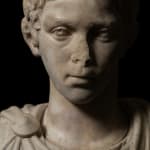Roman
Further images
-
(View a larger image of thumbnail 1
)

-
(View a larger image of thumbnail 2
)

-
(View a larger image of thumbnail 3
)

-
(View a larger image of thumbnail 4
)

-
(View a larger image of thumbnail 5
)

-
(View a larger image of thumbnail 6
)

-
(View a larger image of thumbnail 7
)

-
(View a larger image of thumbnail 8
)

-
(View a larger image of thumbnail 9
)

-
(View a larger image of thumbnail 10
)

-
(View a larger image of thumbnail 11
)

-
(View a larger image of thumbnail 12
)

Provenance
Private collection, Europe, circa 17th/18th Century (based on restoration techniques)Benjamin Smith (1941–2021) Collection, Atlanta, Georgia, acquired prior to 1991. Smith was an American Postwar and Contemporary artist whose work can be found in the collections of the High Museum of Art, the Brooklyn Museum, Morris Museum, New Orleans, University of Kentucky, Lexington, and Brown University, Providence, RI
Literature
Elagabalus, (Heliogabalus) was emperor from AD 218 to 222. Born Varius Avitus Bassianus Marcus Aurelius Antoninus in AD 203 or 204, in Syria, Elagabalus rose to power at age 14, because his mother Julia Soaemias claimed he was Caracalla's illegitimate child to win the support of the Roman army. His mother, and grandmother Julia Maesa, ultimately ran affairs, but Elagabalus was the iconic emperor. Known for his beauty, Elagabalus had large eyes and a youthful, underdeveloped face. He tended to wear gold or purple tunics, and at times a female diadem. His sexual appetites for both men and women became notorious, and he promised a huge reward to any doctor who could perform a sex-change operation. He married at least three women within four years and enacted a series of controversial religious acts promoting worship of the sun-god El-Gabal, of the Syrian city of Emesa, of which his family were high priests. Eventually, the Roman army and senate moved against him, and the women behind his administration began quarrelling. He adopted the future Alexander Severus in an attempt to legitimise his power, but the Praetorian Guards murdered Elagabalus and his mother anyway. See C. Dio, Roman History, Book 80.Due to the fragmentary nature of this portrait it is hard to be sure whether this depicts Elagabalus, or a youth of the same period. The eyes and full lips certainly accord with depictions of the emperor. For a portrait of Elagabalus with similar wavy hair and facial features see the Capitoline Museum, Palazzo Nuovo, Rome, inv. MC0470. There is also a portrait bust of a youth, found at Eleusis, from the time of emperor Elagabalus, now in the National Archaeological Museum of Athens (Inv. No. 2350), which also bears similar facial features including the full lips. For a portrait bust identified as Elagabalus in the Museum of Fine Arts, Boston (acc. no. 1977.337) see C.C. Vermeule et. al., Sculpture in Stone and Bronze in the Museum of Fine Arts, Boston: Additions to the Collections of Greek, Etruscan, and Roman Art, 1971 – 1988, no. 051.











